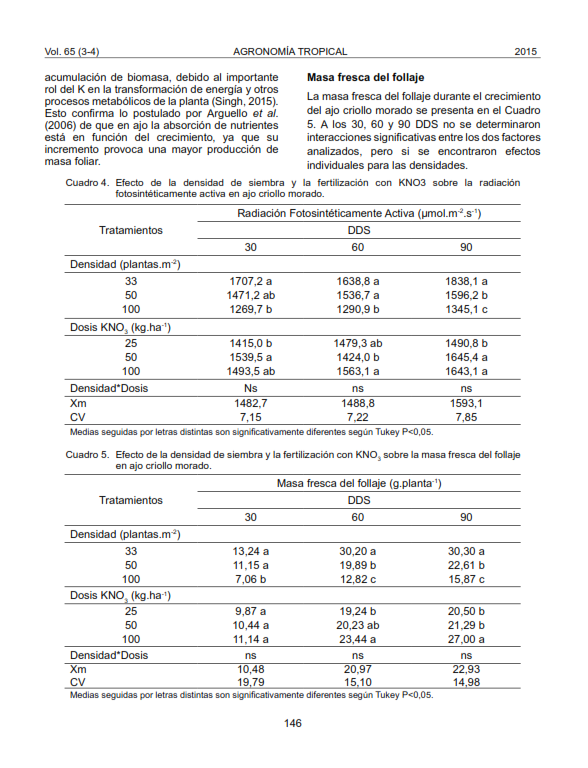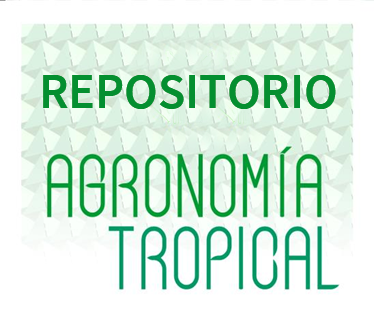Efecto de la densidad de siembra y la nutrición potásica sobre los componentes de crecimiento en ajo morado
Resumen
En Venezuela, el ajo (Allium sativum L.) es un cultivo rentable, aunque presenta algunos problemas en el manejo de la densidad de plantación y la nutrición mineral. El propósito de esta investigación fue evaluar el efecto de la densidad de siembra y las dosis de KNO3 sobre algunos parámetros de crecimiento en ajo criollo morado. Se utilizó un diseño en bloques al azar con arreglo de tratamientos en parcelas divididas, con 3 densidades de siembra: 100, 50 y 33 plantas.m-2; y 3 dosis de KNO3 25, 50 y 100 kg.ha-1. Las variables evaluadas fueron: número de hojas, índice relativo de clorofila, índice de área foliar, radiación fotosintéticamente activa y masa fresca del follaje. Las determinaciones se realizaron a los 30, 60 y 90 días después de la siembra. La interacción entre la densidad y las dosis de KNO3 tuvo un efecto bien marcado sobre el índice de área foliar, pero no sobre las otras variables evaluadas. Se observó un efecto individual de los factores sobre el crecimiento vegetativo de ajo morado; las plantas crecidas en las parcelas menos densas y fertilizadas con las mayores dosis, produjeron el mayor número de hojas, índice relativo de clorofila, radiación fotosintéticamente activa y masa fresca del follaje.
Descargas
Citas
• Arguello, J. A., S. B. Núñez and A. Ledesma, C. Rodríguez y M. del C. Díaz. 2006. Vermicompost effects on bulbing dynamics, nonstructural carbohydrate content, yield, and quality of ‘Rosado Paraguayo’ garlic bulbs. HortScience. 41:589-592.
• Blanke, M. M. 2009. Regulatory mechanisms in source sink relationiships in plant- a review. Acta Hort. 835:13-20.
• Brewster, J. 2011. Onions and other Alliums. 4th ed. Pretence Hill. UK. 210 p.
• Castellanos, J., P. Vargas, J. Ojodeagua, G. Hoyos, G. Alcántar, E. Álvarez and A. Gardea. 2004. Garlic productivity and profitability as affected by seed clove size, planting density and planting method. HortScience 39(6):1272-1277.
• Dale, K. and C. Schumann. 2005. Response of woodland-planted ramps to surface-applied calcium, planting density and bulb preparation. HortScience. 40(5):1516-1520.
• El-Desuki, A., M. Abdel-Mouty and A. Ali. 2006. Response of onion plants to additional dose of potassium application. J. Applied Sci. Research. 2(9):592-597.
• Gaviola, S. and V. M Lipinski. 2008. Effect of nitrogen fertilization on yield and color of red garlic (Allium sativum L.) cultivars. Cien. Inv. Agr. 35(1):57-64.
• Hossain, M., M. Ashrafuzzaman, M. S. Hoque and M. A. Hoque. 2003. Effect of seed clove size and spacing on growth performance of garlic. Muarik Bulletin. 6:123-128.
• Juškevičienė, D., R. Karklelienė, A. Radzevičius and A. Sasnauskas. 2016. Productivity and morphological features of garlic (Allium sativum L.) grown in Lithuania. Agriculture & Forestry. 62(4):109-116.
• Karaye, A. K. and A. I. Yakubu. 2006. Influence of intra-row spacing and mulching on leed growth and bulb yield of garlic (Allium sativum L.) in Sokoto, Nigeria. Afr. J. Biotechnol. 5(3):260-264.
• Karklelienė, R., E. Dambrauskienė, D. Juškevičienė, A. Radzevičius, M. Rubinskienė and P. Viškelis. 2015. Productivity and nutritional value of dill and parsley. Horticultural Sciences 41(3):131-137.
• Karim, A., H. Fukamachi and T. Hidaka. 2003. Photosynthetic performance of Vigna radiate L. leaves developed at different temperature and irradiance levels. Plant Sci. 164:451-458.
• Marschner, H. 2002. Mineral nutrition of higher plants. 4th ed. Academic Press, New York. 358 p.
• Mengel, K. and E. A. Kirkby. 2001. Principles of plant nutrition. Kluwer Academic Publishers. 5th ed. Dordrecht. Boston/London. 549 p.
• Moritzuka, N. and S. Matsumoto. 2006. An experimental approach to quantifying chemical and positional availability of soil potassium. Soil Sci. and Plant Nutr. 52:61- 70.
• Ngouajio, M. 2008. Changes in onion (Allium cepa L.) yield and grade distribution in response to cover crop and plant population. HortScience. 43(4):1138.
• Rahim, M. A. and R. Fordham. 2001. Environmental manipulation for controlling bulbing in garlic. Acta Hort. 555:181-188.
• Rahim, M. A. and R. Fordham. 1991. Effect of shade on leaf and cell size and number of epidermal cells in garlic (Allium sativum L.). Ann. of Botany. 67:167-171.
• Ramírez, H. 2001. Growth and nutrient absorption of onion (Allium cepa L.) in the tropics in response to potassium nutrition. A thesis in partial requirements of the degree of Ph.D. Department of Agricultural Sciences. Imperial College at Wye, London University. 210 p.
• Rosen, C. and C. Tong. 2001. Yield, dry matter partitioning and storage quality of hard neck garlic as affected by soil amendments and scape removal. HortScience. 36(7):1235-1239.
• Saleem, J. M. 2004. Studies on the management strategies for bulb and seed production of different cultivars of onion (Allium cepa L.). A dissertation submitted in partial fulfillment of the requirements for the degree of Doctor Philosophy in Agriculture (Horticulture). Gomal University. Pakistán. 106 p.
• Seversike, T., L. Purcell, E. Gbur, P. Chen and R. Scott. 2009. Radiation interception and yield response to increased leaflet number in early-maturing soybean genotypes. Crop Science. 49:281-289.
• Singh, S. 2015. Planting row arrangement and nutrient management in geranium (Pelargonium graveolens) – garlic (Allium sativum) intercropping. Indian J. Agric. Res. 49(5):407-413.
• Singh, S., M. Ram and N. Yadav. 2014. Effect of phosphorus and zinc application on the growth and yield of geranium (Pelargonium graveolens) intercropped with garlic (Allium sativum). Indian J. Agric. Res. 48(1):1-8.
• Singh, S., B. K. Dubey and R. P. Gupta. 2016. Genotype x environment interaction and stability analysis for yield and its attributes in garlic (Allium sativum L.). Journal of Spices and Aromatic Crops. 25(2):175-181.
• Shabala, S. 2003. Regulation of potassium transport in leaves: From molecular to tissue level. Ann. Bot. 92:627-634.
• Shock, C., E. Feibert and L. Saunders. 2004. Plant population and nitrogen fertilization for subsurface drip-irrigated onion. HortScience. 39(7):1722-1727.
• Stahlschmidt, O., J. Cavagnaro and R. Borgo. 1997. Growth analysis of three garlic (Allium sativum L.) cultivars with differences in yield. Acta Hort. 433:427-434.
• Wang, Y. T. 2007. Potassium nutrition affects Phalaenopsis growth and flowering. Hort Science 42(7)_1563-1567





